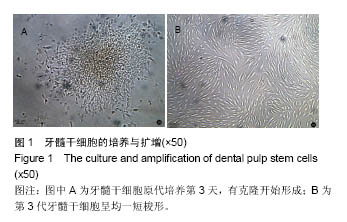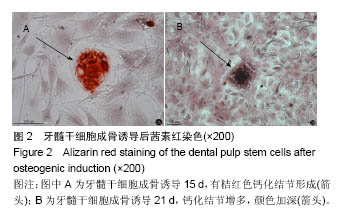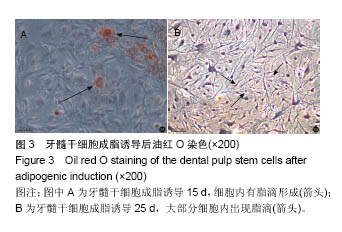| [1]杨媛,彭楚,芳秦满,等.牙髓血运重建术治疗年轻恒牙根尖周病变的临床效果观察[J].中华口腔医学杂志,2013,48(2):81-85.[2]李州,许庆安.干细胞和支架与牙髓再生及其血运重建[J].国际口腔医学杂志,2016,43(3):298-302.[3]Wang Y, Zhao Y, Jia W, et al. Preliminary study on dental pulp stem cell-mediated pulp regeneration in canine immature permanent teeth. J Endod. 2013;39(2):195-201.[4]D'Mello G, Moloney L. Management of coronal discolouration following a regenerative endodontic procedure in a maxillary incisor. Aust Dent J. 2016; 10(3):121-128.[5]Bhardwaj N, Chakraborty S, Kundu SC. Freeze-gelled silk fibroin protein scaffolds for potential applications in soft tissue engineering. Int J Biol Macromol. 2011;49(3):260-267.[6]Woloszyk A, Buschmann J, Waschkies C, et al. Human Dental Pulp Stem Cells and Gingival Fibroblasts Seeded into Silk Fibroin Scaffolds Have the Same Ability in Attracting Vessels. Front Physiol. 2016;7:140.[7]雷鸣,高丽娜,陈发明,等.牙髓组织工程和再生中生物支架材料的进展[J].牙体牙髓牙周病学杂志,2013,23(1):51-56.[8]Cao B, Yin J, Yan S, et al. Porous scaffolds based on cross-linking of poly(L-glutamic acid). Macromol Biosci. 2011; 11(3):427-434. [9]别利克孜•卡德尔,刘奕杉,王璇,等.改良酶消化法分离培养人乳牙牙髓干细胞[J].中国组织工程研究,2013,17(10):1793-1800. [10]Gong T, Heng BC, Lo EC, et al. Current Advance and Future Prospects of Tissue Engineering Approach to Dentin/Pulp Regenerative Therapy. Stem Cells Int. 2016;2016:9204574.[11]Conde MC, Chisini LA, Demarco FF, et al. Stem cell-based pulp tissue engineering: variables enrolled in translation from the bench to the bedside, a systematic review of literature. Int Endod J. 2016;49(6):543-550.[12]Piva E, Silva AF, Nör JE. Functionalized scaffolds to control dental pulp stem cell fate. J Endod. 2014;40(4 Suppl):S33-40. [13]王洁,刘加强,房兵.牙髓干细胞在组织工程中的研究进展[J].口腔颌面修复学杂志,2013,14(3):183-186.[14]史诗彧,谢家敏. 牙髓干细胞在组织工程领域的研究进展[J].华西口腔医学杂志,2015,33(6):656-659.[15]任飞,周慧,刘建平,等.转化生长因子β3联合肝素在人乳牙牙髓干细胞向成牙本质样细胞分化中的作用[J].实用医学杂志,2014, 30(12):1887-1890.[16]王亦菁,张晓东,李里,等.三维培养的牙髓干细胞参与牙髓损伤修复能力的实验研究[J].临床口腔医学杂志,2011,27(10): 582-584.[17]贺慧霞,金岩,史俊南, 等. bFGF、TGF-β对人牙髓干细胞增殖和分化能力的影响[J].牙体牙髓牙周病学杂志,2004,14(7): 359-363.[18]林颖,秦伟,邹瑞, 等.促丝裂原激活蛋白激酶在牙髓干细胞向成牙本质细胞分化和牙髓损伤修复中的作用[J].国际口腔医学杂志,2016,43(3):343-347.[19]Leong DJ, Setzer FC, Trope M, et al. Biocompatibility of two experimental scaffolds for regenerative endodontics. Restor Dent Endod. 2016;41(2):98-105.[20]年争好,李晖,李瑞欣,等.纳米羟基磷灰石/胶原蛋白/丝素蛋白复合骨组织工程支架材料的生物相容性[J].中国组织工程研究, 2015,19(8):1149-1154.[21]吕孝帅,李正茂,王海燕, 等. 生物活性玻璃-丝素蛋白复合膜支持人牙髓干细胞增殖与分化初探[J].中华口腔医学杂志,2015, 50(12):725-730.[22]李珊,樊明文,梁素霞.成人牙髓干细胞与壳聚糖-磷酸三钙复合材料相容性试验研究[J].口腔医学研究,2006,22(3):264-266.[23]Baniasadi H, Ramazani S A A, Mashayekhan S. Fabrication and characterization of conductive chitosan/gelatin-based scaffolds for nerve tissue engineering. Int J Biol Macromol. 2015;74:360-366.[24]Shukla SK, Mishra AK, Arotiba OA, et al. Chitosan-based nanomaterials: a state-of-the-art review. Int J Biol Macromol. 2013;59:46-58.[25]Jridi M, Hajji S, Ayed HB, et al. Physical, structural, antioxidant and antimicrobial properties of gelatin-chitosan composite edible films. Int J Biol Macromol. 2014;67:373-379.[26]Douglas TE, Krok-Borkowicz M, Macuda A, et al. Enrichment of thermosensitive chitosan hydrogels with glycerol and alkaline phosphatase for bone tissue engineering applications. Acta Bioeng Biomech. 2016;18(2):51-57.[27]沈剑虹,杨甫,姚麒,等.结合bpV(pic)的壳聚糖支架对神经干细胞生长分化的影响[J].中华实验外科杂志,2015,32(8):1925-1928.[28]薛震,牛丽媛,安刚,等.纳米羟基磷灰石/壳聚糖/半水硫酸钙为可注射骨组织工程支架材料的可行性[J].中国组织工程研究,2015, 19(8):1160-1164.[29]祁伟,左强,崔维顶,等.采用纤维蛋白凝胶种植技术体外构建组织工程软骨[J].江苏医药,2011,37(12): 13 68-1370.[30]Ding B, Gao H, Song J, et al. Tough and Cell-Compatible Chitosan Physical Hydrogels for Mouse Bone Mesenchymal Stem Cells in Vitro. ACS Appl Mater Interfaces. 2016;8(30): 19739-19746.[31]刘清宇,王富友,刘俊利,等.含有天然钙化软骨层骨软骨支架的研制[J].中华创伤杂志,2014,30(5):467-470.[32]鳄贤,邵林.骨组织工程多孔陶瓷支架制备工艺的研究进展[J].医学临床研究,2014,31(3):551-554. [33]Buizer AT, Veldhuizen AG, Bulstra SK, et al. Static versus vacuum cell seeding on high and low porosity ceramic scaffolds. J Biomater Appl. 2014;29(1):3-13.[34]聂姗姗,刘佳,张瑞涵,等.牙髓干细胞MHC分子表达与体外混合淋巴细胞的增殖[J].中国组织工程研究, 2014,18(50): 8162-8167. |
.jpg)





.jpg)